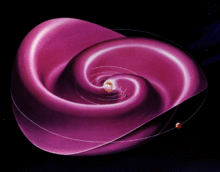Interplanetary magnetic field
As interplanetary magnetic field ( English interplanetary magnetic field , IMF ) or solar magnetic field ( English solar magnetic field ) is defined as the magnetic field of the sun , which in the space (in the Heliosphäre is measured) outside the direct influence of the planets.
shape
Without the influence of the solar wind , the magnetic field of the calm sun would be weaker like a dipole field with the third power of the distance. A strength of 10 −11 Tesla would be expected near the earth's orbit . In fact, however, one measures fields of 4 to 10 nT that are approximately 100 times larger. The reason for this is that the solar wind is not a simple gas , but an electrically conductive plasma . Thereby it conducts and carries the magnetic field of the sun out into the interplanetary space . The rotation of the sun creates a magnetic field in the form of a rotating spiral around the area of the solar equatorial plane.
Depending on the hemisphere and phase of the solar wind, the magnetic field follows spiral field lines inwards or outwards. The spiral shape is the same in the northern and southern hemisphere, but with the field direction reversed. The north and south magnetic fields are separated by an electric current layer in which a small electric current flows. This heliospheric current layer has a shape similar to a rotating ballerina skirt and is also called the " Parker spiral" after the American astrophysicist Eugene N. Parker . However, due to changes in the sun, the Parker spiral is only an ideal shape. In practice it is in constant motion and change.
The heliospheric current layer rotates with a period of about 25 days. Thus, the earth crosses the current layer several times a year and is in between in the area of the north and south of the sun's magnetic fields.
The relative angle of the heliospheric current layer to the ecliptic is variable and depends on solar activity. The stronger the activity, the steeper and more “fluffy” the Parker spiral becomes. It is flat when there is little activity. Because the sun's magnetic field reverses about every 11 years , the waveform of the heliospheric current layer also changes in an approximate 11-year cycle.
The investigation of the interactions between plasmas, magnetic and electric fields takes place within the framework of magnetohydrodynamics . The IAGA is responsible for this topic within the framework of the international scientific union IUGG .
Interaction with other magnetic fields
The solar wind interacts with the magnetic fields of planets such as Earth and Jupiter and limits their magnetospheres by a shock front . For the outermost zone of the solar system there are indications of a similar limitation of the heliosphere with a comparable structure of plasma layer ( helio envelope ) and heliopause at the border to interstellar space .
Web links
Individual evidence
- ↑ Interplanetary magnetic field. In: Carsten Könneker, Spektrum der Wissenschaft Verlagsgesellschaft mbH. December 4, 2014, accessed September 9, 2019 .
- ↑ The interplanetary magnetic field. In: Berndt Klecker, Stars and Space Special 01/2017, Our sun - the engine of space weather. 2007, accessed September 9, 2019 .
- ↑ Computer program to predict geomagnetic storms - image of science. In: Wissenschaft.de. Retrieved September 28, 2015 .

